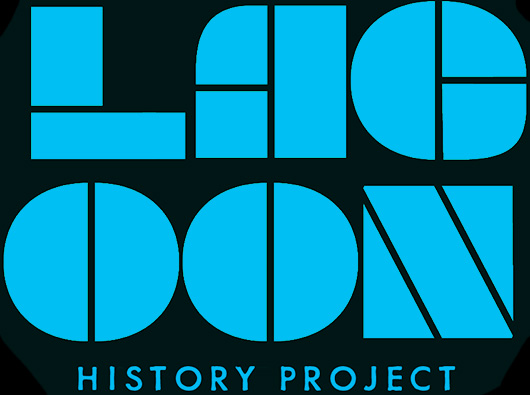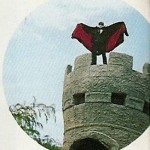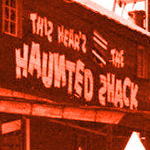
When entering Terroride and Dracula’s Castle guests are confronted with a collection of bizarre and mysterious images. Both rides were originally designed by Bill Tracy, who created haunted attractions across the country and knew the importance of making the outside of the building as impressive as what was inside.
“The façade was the marketing and advertisement for the ride and hopefully lured a person to use some of their precious ride tickets on that particular attraction. This design strategy was definitely apparent as no other dark ride designer of the era developed such decorative and complex façades as Bill.”
The Bill Tracy Project
First, Terroride was introduced in 1967 with a large mural in the loading area depicting a weird mix of creatures in an exotic setting. Seven years later, the larger Dracula’s Castle was added with towers, turrets and eerie relief sculptures scattered all over the building.
Many of the images were inspired by ancient artwork and symbols from Egypt, Greece, Assyria and other cultures. By digging a little deeper, it’s possible to see how the inclusion these images may have been more intentional than haphazard. Could there be an undiscovered backstory that somehow ties them all together?

Going down this rabbit hole probably won’t lead to an adventure like in an Indiana Jones or National Treasure movie (…will it?), but it can be entertaining while waiting in the queue to consider these cryptic connections and how they relate to Dracula.
To assist the curious, here is a brief background on the artwork and symbols decorating Dracula’s abode.
EYE OF HORUS

Horus was the Egyptian sky god and son of Osiris. This hieroglyph, found above the exit, symbolizes protection or action. The markings around the eye are meant to resemble those found on a falcon, which is how Horus was often depicted.
MEDUSA

Flanked by two snakes above the entrance is Medusa – a monster from Greek mythology with poisonous snakes for hair. Anyone who looked at her face would turn to stone. She was beheaded by Perseus who kept her head in a bag and used it as a weapon against his enemies. From the Archaic Period to the Hellenistic Period, her image was used in architecture and other ornamental uses to chase away evil.
APKALLU

Apkallu is an eagle-headed demigod believed to have brought civilization and culture to mankind. This particular image closely resembles a panel from the North West Palace of Ashurnasirpal II in present-day Iraq. Another relief from that palace is also included on the back wall of the loading area.
SKULL & SUN

Between between the two towers, on the wall above the loading area, there are three round images that are harder to pin down. On the left is what looks like a skull with sun rays extending out from behind it. The Aztecs used skulls and suns a lot as symbolism in their ancient temples. This one has some very basic similarities to the Disc of Mictlantecuhtli, except for the tongue sticking out. Mictlantecuhtli was the Aztec God of Death and ruled the lowest level of the underworld.
THE DEVIL

The image in the center also doesn’t seem to be an exact copy of any particular piece of artwork. But it does share characteristics of the Devil tarot card, specifically in the Rider-Waite-Smith deck (originating in 1910) which shows a goat-headed creature partially based on Eliphas Levi’s Baphomet. Both have a bearded creature with an inverted pentagram between his horns. The Devil tarot card represents physical pleasure, obsession with money, power and material possessions. Dracula can probably relate to at least a couple of those.
UNKNOWN WOMAN

The third round image on this wall shows a woman in front of what could be considered a sun or star with sixteen points. The Macedonians used a sixteen-point sun called the Vergina Sun as a symbol of the Argead Dynasty – the first family of Macedonian rulers which included Alexander the Great. Four rays represented earth, ocean, fire and air while the other twelve rays each represented one of the gods of Olympus. As a whole, the Vergina Sun was the symbol of the goddess Athena, who could be the woman depicted in the center. The Vergina Sun also symbolized virginity. Many stories of vampires say that the blood of a virgin is poisonous to vampires, others say the opposite. Or it could have no meaning at all.
ASHURNASIRPAL II HUNTING LIONS

King of Assyria from 883 to 859 BC, Ashurnasirpal II conquered Asia Minor and many other nations uninhibited until he reached the Mediterranean Sea. The relief panel above was found in the same palace as the one showing Apkallu mentioned earlier. This image may have also served as inspiration for the lone lion standing on his hind legs on the upper wall of Dracula’s Castle.
NEKHBET

Nekhbet was one of the earliest Egyptian goddesses who sometimes appeared in the form of a vulture. In this image, Nekhbet is clutching a Shen Ring, a symbol of eternity. It was often seen above the king and was a sign of protection.
THE OTHERS…

There’s still many more images strewn across the front of the ride including bats, snakes, birds, monsters and other indiscernible objects. There’s one more larger image that’s hard to get a good look at because it’s visible only after you begin the ride. Just before going through the first set of doors, there’s an image of someone holding a knife in one hand and another hand holding the head of a snake which is wrapped around them. One possible source of inspiration for this image is Durga, the dark side of the Hindu Mother Goddess, Devi. Those who worship Durga offer blood sacrifices to draw upon her dark powers.
CONNECTIONS TO DRACULA

The Dracula that most people think about today is the fictional character created in the 1890s by Irish author Bram Stoker. He loosely based his character on a real person, Vlad III, who ruled what is now part of Romania beginning in 1456. Vlad’s father was instrumental in the creation of the Order of the Dragon and took the surname Dracul, meaning “dragon”. Vlad III was known as Dracula or “son of the dragon”. The Order of the Dragon is believed to have origins involving the Grand Assembly of the Annunaki in ancient Mesopotamia.
Horrific stories of his battle tactics spread throughout Europe. Since his death, the real Dracula has proven to be just as mysterious as Stoker’s Count Dracula. The location of his burial place has been disputed for ages. Some have reported finding his grave empty while others claim to have found his grave with a decapitated body inside.
The symbols found on Dracula’s Castle come from a variety of cultures, many of which were known to share stories of vampires or vampire-like creatures. There are symbols from Assyria and Egypt where impaling was practiced. Vlad Dracul also used this form of torture, earning him the nickname Vlad the Impaler.
The stories of Vlad Dracul were probably exaggerated as they were passed along in medieval times. Bram Stoker’s Dracula was a huge departure from the real Dracula. Movies and books based on Stoker’s vampire have, in turn, taken many liberties with the character. So it seems there’s room for anyone to develop their own connections and interpretations of Lagoon’s representation of Dracula’s Castle as well.
Perhaps designer Bill Tracy meant to incorporate vaguely connected images in order to let guests use their imaginations to fill the gaps. Or he could’ve simply intended to disorient and mystify guests before experiencing the weird collection of scenes inside. The answer has probably gone to the grave with Bill Tracy.
Now that you have a little more of the story behind the imagery, what connections have you made? Leave a reply at the bottom of the page to discuss what you’ve found.

MORE FROM LHP

SOURCES
The Dragon Court – Assembly of the Annunaki’s solution. BibliotecaPleyades.net, Jul 2003.
Sun of Vergina – A Greek Symbol. History Of Macedonia, 10 Apr 2008.
Cartwright, Mark. Mictlantecuhtli. Ancient History Encylcopedia, 22 Sep 2013.
Cartwright, Mark. Devi. Ancient History Encyclopedia, 5 Dec 2015.
Amin, Osama S. M. Assyrian Lion-Hunting at the British Museum. Ancient History Et Cetera, 15 Mar 2016.
Glennon, Madeleine. Medusa In Ancient Greek Art. The Metropolitan Museum Of Art, March 2017.
About the Reliefs and Inscriptions. The Karnak Great Hypostyle Hall Project. The University of Memphis, accessed 28 May 2017.
Bill Tracy’s Personal Life. The Bill Tracy Project, accessed 28 May 2017.
Preskar, Peter. Vlad III “the Impaler” was The Real Dracula. Medium.com, 8 May 2020.
Vlad the Impaler. Dracula’s Homepage, accessed 15 Oct 2020.





4 replies on “Decoding Dracula’s Castle”
This is fascinating! I’ve always wondered what those images meant. Thank you!
My Dad was an artist in so many ways. We were living in Farmington at the time, when he was approached to do the Terroride and Dracula’s Castle outside cement work. I remember having many of the sculpted figures in our yard as they were being carved out of poured cement. The figures were later placed on the castle. Some figures were carved right on the walls. My Dad Ray Jensen and my first cousin Wayne Sylvester were the artist that done the work. My Dad passed away over 30 years ago and I often see his work on homes and buildings throughout Utah. One of his last homes was one he owned in Monroe Utah. He did the outside of this home similar to the outside of the rides in Lagoon. I have loved this family home and have tried to keep it in the family, unfortunately it may be sold because a sibling wants to sell or be bought out. Thank you for keeping these two amazing rides in your park. I have many great memories of Lagoon being so close when we lived in Farmington. If you have any photos of this work being done I would enjoy seeing them.
Thanks for sharing. That’s amazing. I’ve always thought the exteriors were done by local craftsmen since no other Bill Tracy rides are quite like Lagoon’s. I wish I had photos of the construction, but haven’t come across anything yet.
Great breakdown on the images on Drac’s Castle. Have been going to it since it opened in 1974. Bill Tracy understood showmanship and how to hook people with good plausible mythology.